Answered step by step
Verified Expert Solution
Question
1 Approved Answer
A hallmark of chaos is extreme sensitivity both to initial conditions and to model parameters. A very simple hypothetical mechanical model exhibiting such extreme
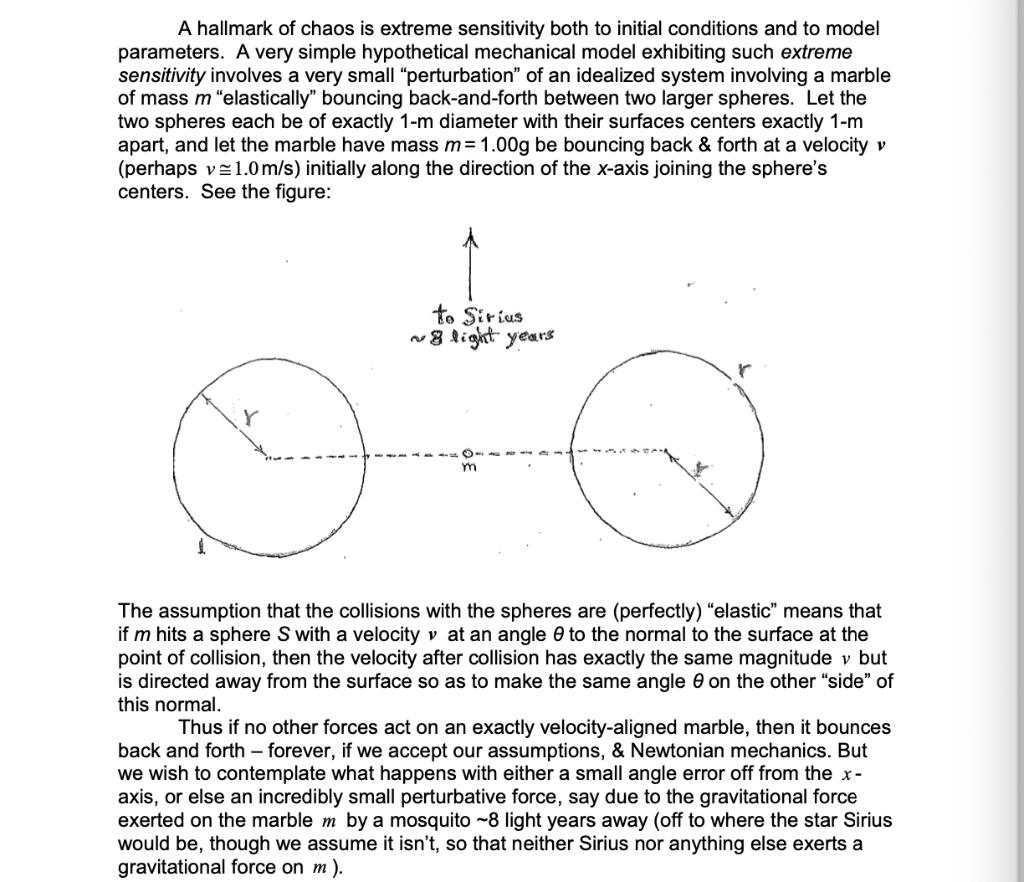
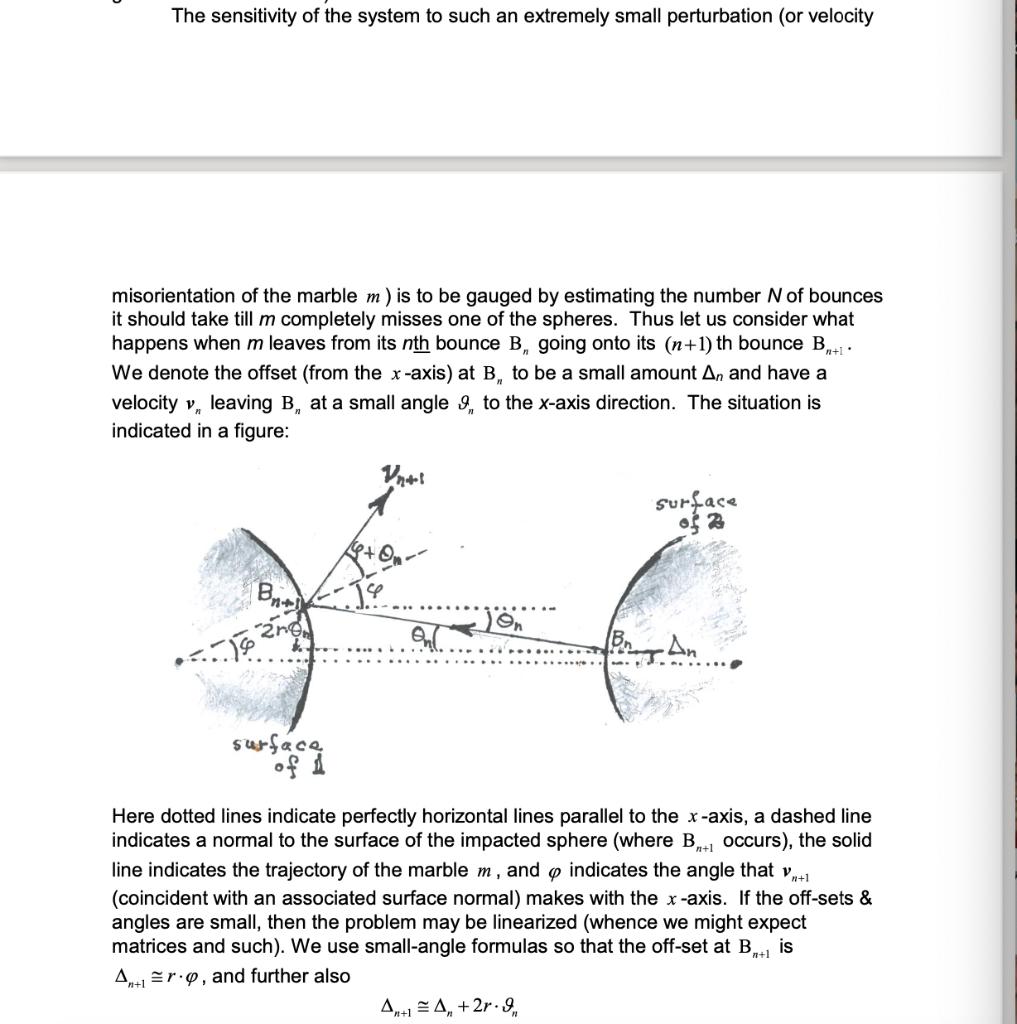
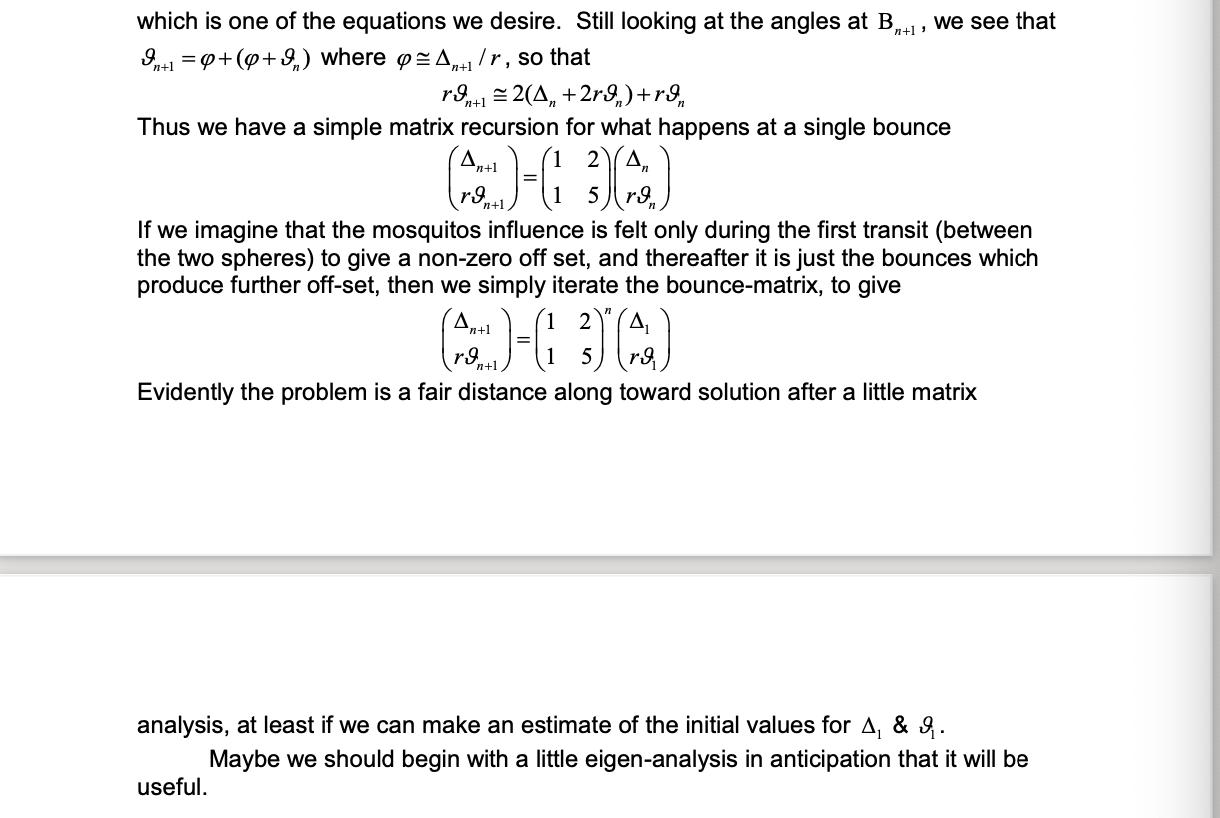
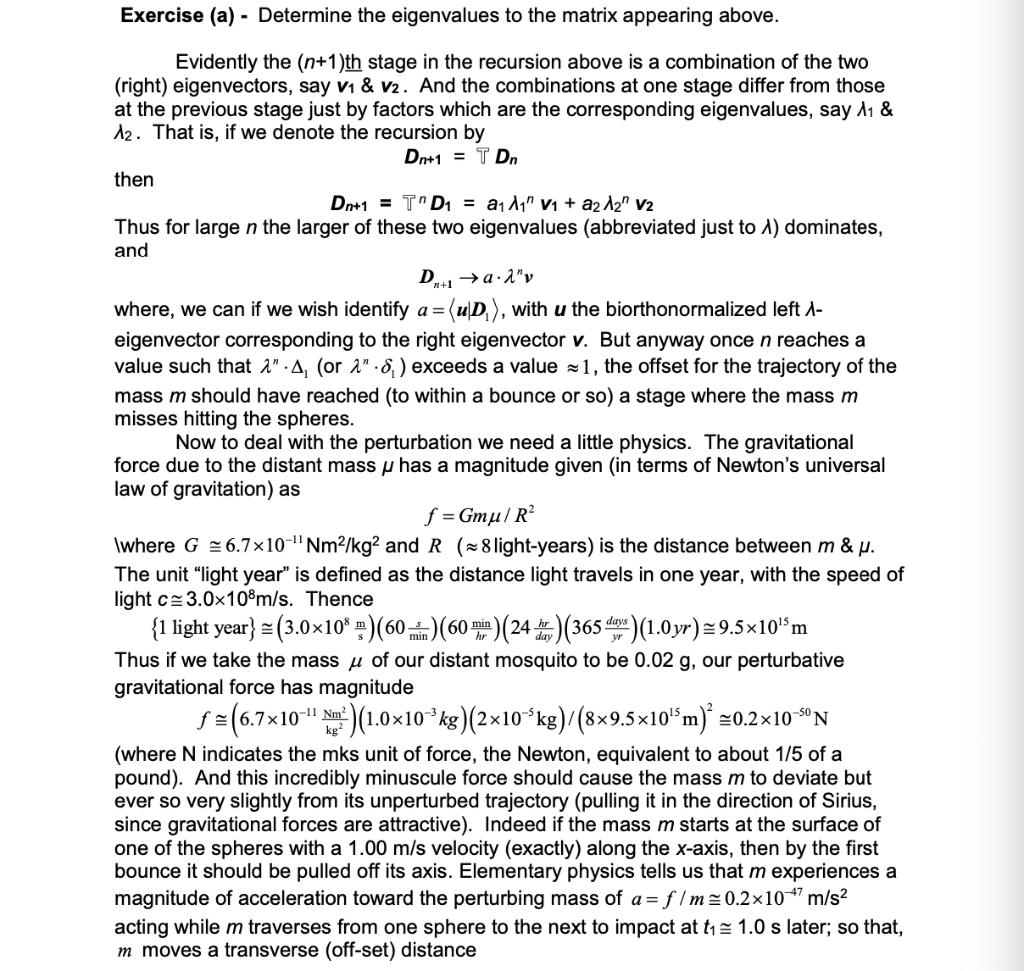
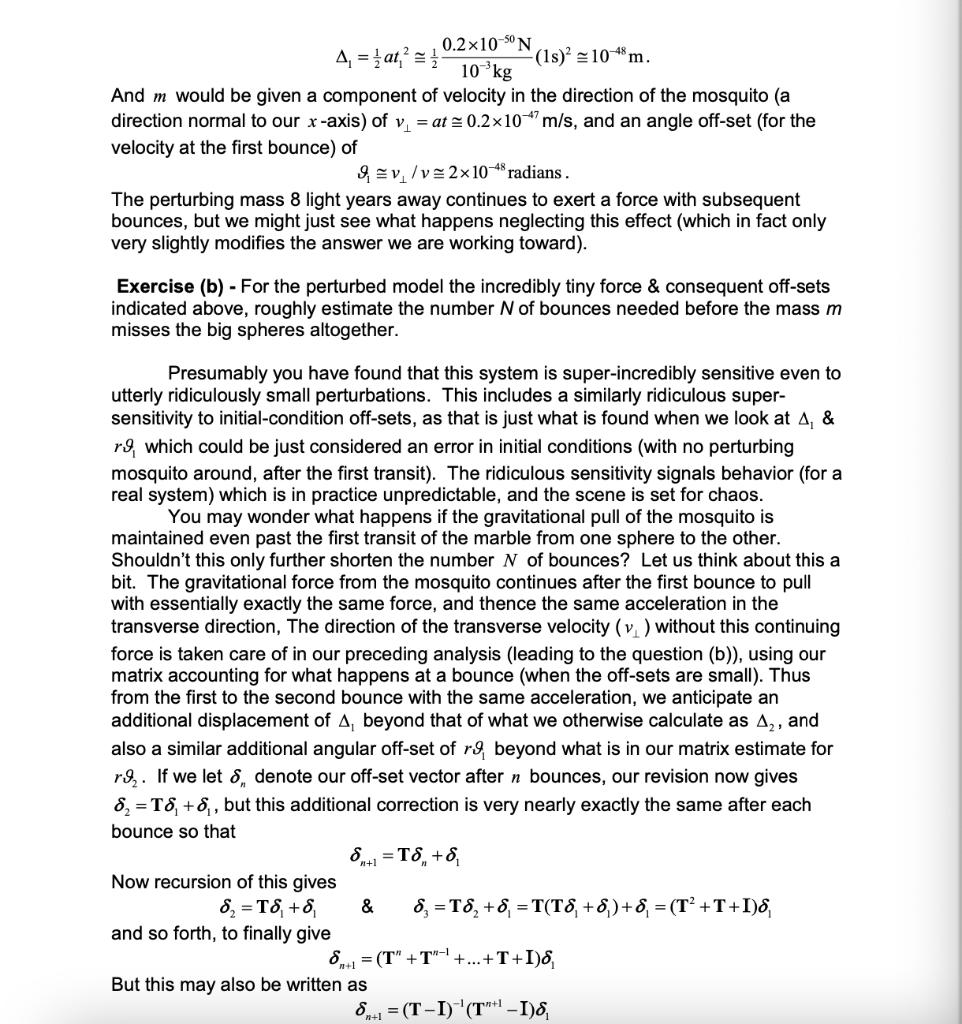
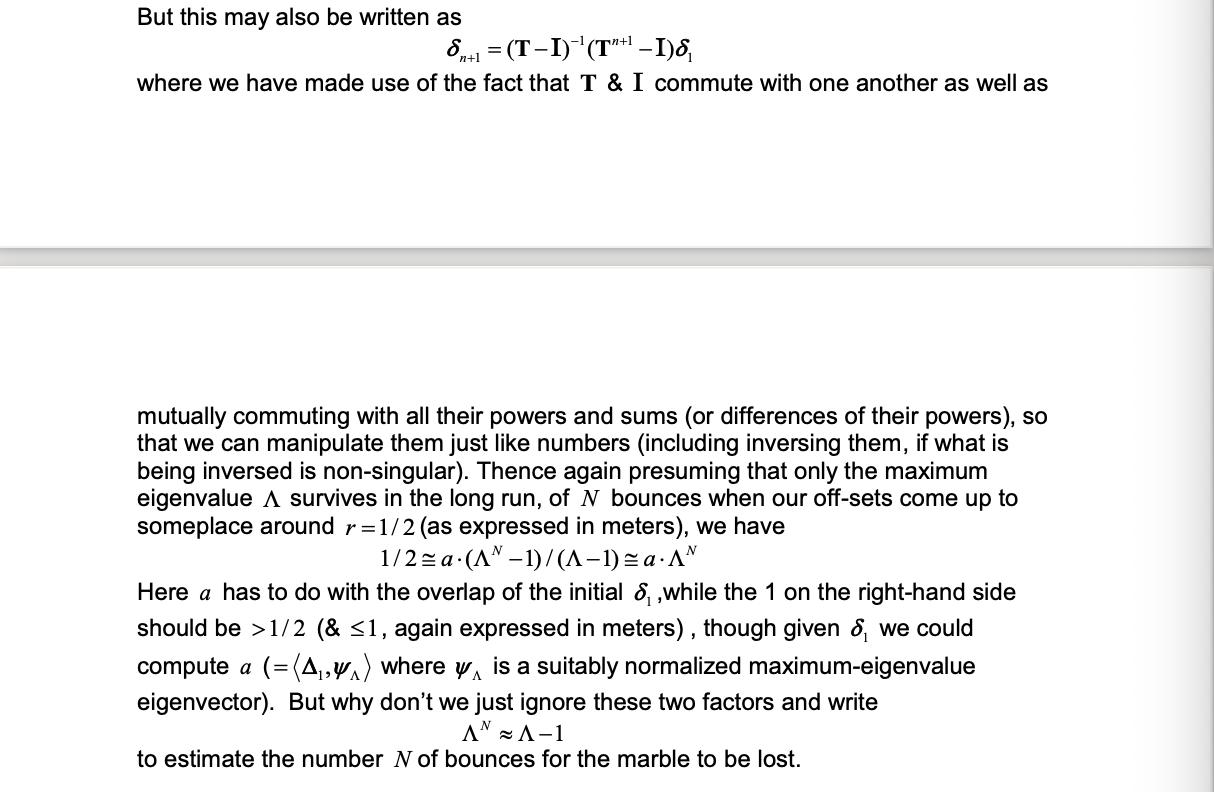
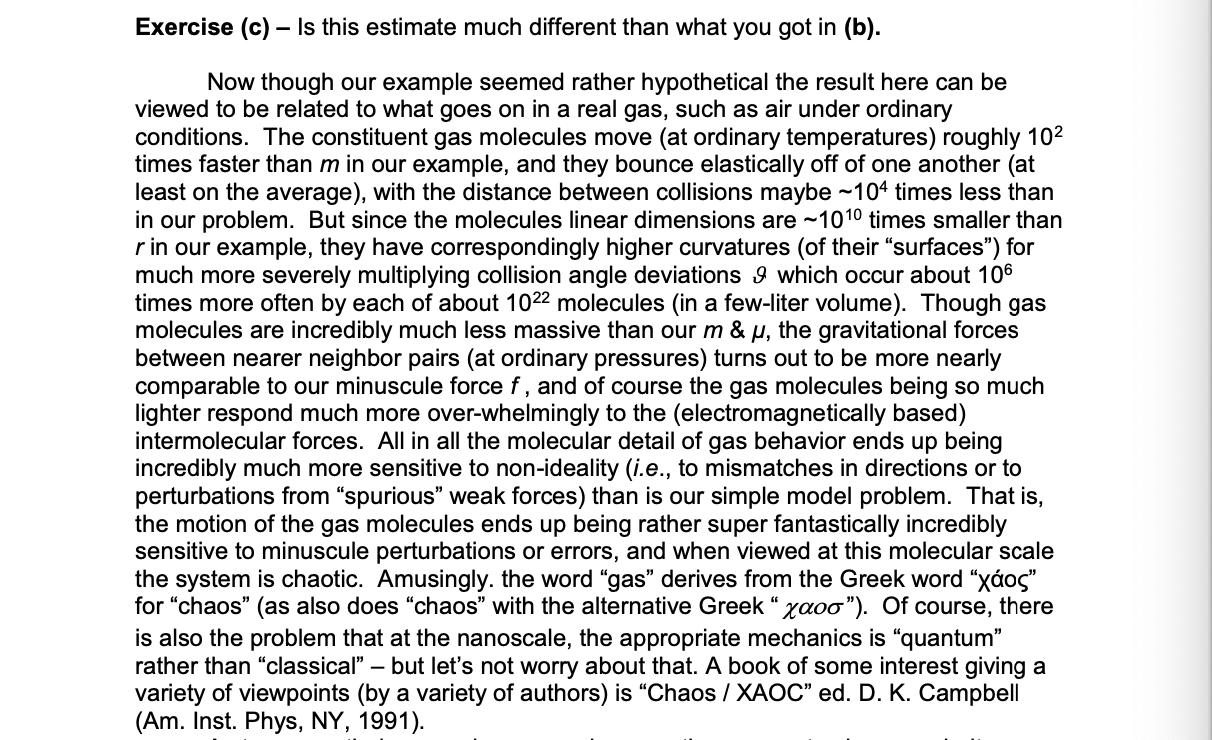

A hallmark of chaos is extreme sensitivity both to initial conditions and to model parameters. A very simple hypothetical mechanical model exhibiting such extreme sensitivity involves a very small "perturbation" of an idealized system involving a marble of mass m "elastically" bouncing back-and-forth between two larger spheres. Let the two spheres each be of exactly 1-m diameter with their surfaces centers exactly 1-m apart, and let the marble have mass m= 1.00g be bouncing back & forth at a velocity v (perhaps ve1.0m/s) initially along the direction of the x-axis joining the sphere's centers. See the figure: to Sirius ~8 light years The assumption that the collisions with the spheres are (perfectly) "elastic" means that if m hits a sphere S with a velocity v at an angle 0 to the normal to the surface at the point of collision, then the velocity after collision has exactly the same magnitude v but is directed away from the surface so as to make the same angle 0 on the other "side" of this normal. Thus if no other forces act on an exactly velocity-aligned marble, then it bounces back and forth - forever, if we accept our assumptions, & Newtonian mechanics. But we wish to contemplate what happens with either a small angle error off from the x- axis, or else an incredibly small perturbative force, say due to the gravitational force exerted on the marble m by a mosquito -8 light years away (off to where the star Sirius would be, though we assume it isn't, so that neither Sirius nor anything else exerts a gravitational force on m ). The sensitivity of the system to such an extremely small perturbation (or velocity misorientation of the marble m) is to be gauged by estimating the number N of bounces it should take till m completely misses one of the spheres. Thus let us consider what happens when m leaves from its nth bounce B, going onto its (n+1) th bounce Bi . We denote the offset (from the x-axis) at B, to be a small amount An and have a velocity v, leaving B, at a small angle 9, to the x-axis direction. The situation is indicated in a figure: surface B An surface of 1 Here dotted lines indicate perfectly horizontal lines parallel to the x-axis, a dashed line indicates a normal to the surface of the impacted sphere (where B1 occurs), the solid line indicates the trajectory of the marble m, and o indicates the angle that vp-1 (coincident with an associated surface normal) makes with the x-axis. If the off-sets & angles are small, then the problem may be linearized (whence we might expect matrices and such). We use small-angle formulas so that the off-set at B. is A Er.p, and further also An+1 =4, +2r 9, which is one of the equations we desire. Still looking at the angles at B,, we see that n+11 941 =9+(@+9,) where o=A /r, so that n+1 r91 = 2(A, +2r9,) +r9, Thus we have a simple matrix recursion for what happens at a single bounce 2A, n+1 If we imagine that the mosquitos influence is felt only during the first transit (between the two spheres) to give a non-zero off set, and thereafter it is just the bounces which produce further off-set, then we simply iterate the bounce-matrix, to give 'n+1 r9 n+1 Evidently the problem is a fair distance along toward solution after a little matrix analysis, at least if we can make an estimate of the initial values for A, & 9. Maybe we should begin with a little eigen-analysis in anticipation that it will be useful. Exercise (a) - Determine the eigenvalues to the matrix appearing above. Evidently the (n+1)th stage in the recursion above is a combination of the two (right) eigenvectors, say vi & v2. And the combinations at one stage differ from those at the previous stage just by factors which are the corresponding eigenvalues, say A1 & A2. That is, if we denote the recursion by Dn+1 = T Dn then Dn+1 = T"D1 = a1A" v1 + a2 A2" V2 Thus for large n the larger of these two eigenvalues (abbreviated just to A) dominates, and D1 a.2"v n+1 where, we can if we wish identify a= (uD,), with u the biorthonormalized left A- eigenvector corresponding to the right eigenvector v. But anyway once n reaches a value such that 2" A, (or 2" -8,) exceeds a value x1, the offset for the trajectory of the mass m should have reached (to within a bounce or so) a stage where the mass m misses hitting the spheres. Now to deal with the perturbation we need a little physics. The gravitational force due to the distant mass u has a magnitude given (in terms of Newton's universal law of gravitation) as f = Gm/ R? \where G = 6.7x10-"Nm?/kg? and R (8 light-years) is the distance between m & u. The unit "light year" is defined as the distance light travels in one year, with the speed of light c= 3.0x10m/s. Thence {1 light year} = (3.0x10* m)(60)(60 in)(24 )(365 )(1.0yr) =9.510*m Thus if we take the mass u of our distant mosquito to be 0.02 g, our perturbative gravitational force has magnitude s=(6.7x10" )(1.0x10*kg)(210*kg)/(89.5x10*m)* =0.210 "N -11 Nm2 -50 (where N indicates the mks unit of force, the Newton, equivalent to about 1/5 of a pound). And this incredibly minuscule force should cause the mass m to deviate but ever so very slightly from its unperturbed trajectory (pulling it in the direction of Sirius, since gravitational forces are attractive). Indeed if the mass m starts at the surface of one of the spheres with a 1.00 m/s velocity (exactly) along the x-axis, then by the first bounce it should be pulled off its axis. Elementary physics tells us that m experiences a magnitude of acceleration toward the perturbing mass of a= f/m 0.2x104 m/s? acting while m traverses from one sphere to the next to impact at t= 1.0 s later; so that, m moves a transverse (off-set) distance 0.2x10 5 N 10*kg And m would be given a component of velocity in the direction of the mosquito (a direction normal to our x-axis) of v, = at = 0.2x10 " m/s, and an angle off-set (for the A = } at, = } (1s)' =10 m. velocity at the first bounce) of 9 Ev, /v= 2x 10 4 radians. The perturbing mass 8 light years away continues to exert a force with subsequent bounces, but we might just see what happens neglecting this effect (which in fact only very slightly modifies the answer we are working toward). Exercise (b) - For the perturbed model the incredibly tiny force & consequent off-sets indicated above, roughly estimate the number N of bounces needed before the mass m misses the big spheres altogether. Presumably you have found that this system is super-incredibly sensitive even to utterly ridiculously small perturbations. This includes a similarly ridiculous super- sensitivity to initial-condition off-sets, as that is just what is found when we look at A, & r9 which could be just considered an error in initial conditions (with no perturbing mosquito around, after the first transit). The ridiculous sensitivity signals behavior (for a real system) which is in practice unpredictable, and the scene is set for chaos. You may wonder what happens if the gravitational pull of the mosquito is maintained even past the first transit of the marble from one sphere to the other. Shouldn't this only further shorten the number N of bounces? Let us think about this a bit. The gravitational force from the mosquito continues after the first bounce to pull with essentially exactly the same force, and thence the same acceleration in the transverse direction, The direction of the transverse velocity (v, ) without this continuing force is taken care of in our preceding analysis (leading to the question (b)), using our matrix accounting for what happens at a bounce (when the off-sets are smallI). Thus from the first to the second bounce with the same acceleration, we anticipate an additional displacement of A, beyond that of what we otherwise calculate as A,, and also a similar additional angular off-set of r9, beyond what is in our matrix estimate for r9,. If we let 8, denote our off-set vector after n bounces, our revision now gives 8, = T, +8,, but this additional correction is very nearly exactly the same after each bounce so that 8 = T8, +8, n+1 Now recursion of this gives 8, = T, +8, and so forth, to finally give & 8, = T, +, = T(T, +8,)+8, = (T +T+I)8, = (T" + T"+..+T+I)8, But this may also be written as 81 = (T-I) (T"* I)8, But this may also be written as 8 = (T-I) (T"*! -I)8, n+1 where we have made use of the fact that T & I commute with one another as well as mutually commuting with all their powers and sums (or differences of their powers), so that we can manipulate them just like numbers (including inversing them, if what is being inversed is non-singular). Thence again presuming that only the maximum eigenvalue A survives in the long run, of N bounces when our off-sets come up to someplace around r=1/2 (as expressed in meters), we have 1/2z a (A" -1)/(A-1) = a AN Here a has to do with the overlap of the initial 8, ,while the 1 on the right-hand side should be >1/2 (&
Step by Step Solution
★★★★★
3.38 Rating (151 Votes )
There are 3 Steps involved in it
Step: 1

Get Instant Access to Expert-Tailored Solutions
See step-by-step solutions with expert insights and AI powered tools for academic success
Step: 2

Step: 3

Ace Your Homework with AI
Get the answers you need in no time with our AI-driven, step-by-step assistance
Get Started


